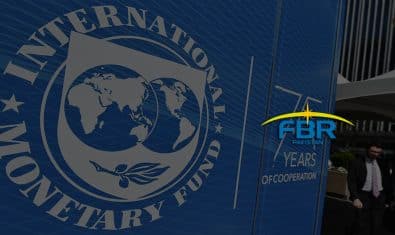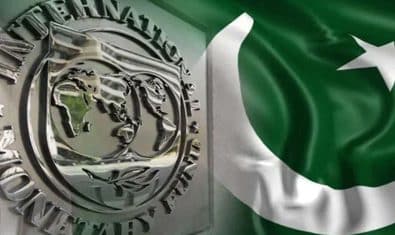The World Bank has projected positive growth return for Pakistan in fiscal year 2023-24, but at a rate of only 1.7 percent, while saying that the economy remains dependent on capital inflows to finance substantial fiscal and current account deficits.
The Bank in its latest report “South Asia Development Update Toward faster, cleaner growth”, stated that Pakistan’s economic situation is also fragile.
The US dollar value of goods imports shrank by 26 percent in the year to August 2023 as a result of low demand alongside import and capital controls. Input shortages have affected production, with exports declining 5 percent in the year to August and industrial production shrinking by 15 percent in the year to June 2023.
Pakistan’s economy is estimated to have shrunk by 0.6 percent in fiscal year 2022-23, reflecting widespread damage from the 2022 floods, elevated inflation, and difficulties with its balance of payments.
Positive growth is projected to return in fiscal year 2023-24, but at a rate of only 1.7 percent. The economy remains dependent on capital inflows to finance substantial fiscal and current account deficits. Import controls intended to narrow the trade deficit have also impeded the supply of industrial raw materials and depressed growth more than expected.
These controls have been removed this year as an IMF lending program has stabilized the currency and boosted business confidence. Nonetheless, the economy still faces substantial challenges from continued inflation pressures, tight fiscal policy related to debt repayments, and extensive flood damage.
Critical Forex Reserves, CAD
Pakistan’s foreign exchange reserves remain low, leaving the country with limited buffers against external shocks, the Bank added.
The Bank stated that not all countries in the region are growing fast, and three—Afghanistan, Pakistan and Sri Lanka—are in acute crisis.
Activity in Bangladesh, Pakistan, and Sri Lanka has continued to suffer from the aftermaths of recent balance-of-payments crises. All three countries have recently begun to implement IMF-supported policy programs to stem capital outflows and improve debt sustainability. Activity in all three cases has continued to be hampered by input shortages related partly to higher import costs and supply disruptions associated with remaining import restrictions. In all three countries, fiscal deficits remain large, while current account deficits have improved amid sharp import compressions.
The rise in global prices resulting from the end of the pandemic and Russia’s invasion of Ukraine worsened local vulnerabilities in several countries in the region, leading to increases in current account deficits and currency depreciations. These were met with the imposition of import controls. As a result of these overlapping factors, several countries saw large increases in domestic inflation, especially Bangladesh, Nepal, Pakistan, and Sri Lanka, it added.
Inflation, PKR
In Pakistan, consumer price inflation stood at 27 percent in the year to August, down from a peak of 38 percent in May. The decline reflected the stabilization of the exchange rate since the beginning of the year, following 18 months of substantial depreciation, as well as an unwinding of the food price spike caused by the widespread damage from last year’s floods. The central bank has tightened monetary policy to combat high inflation, increasing its benchmark interest rate by 100 basis points most recently in June, to 22 percent.
Financial stresses were most severe in Pakistan and Sri Lanka. In Pakistan, the rupee depreciated sharply between early 2022 and early 2023, and has been broadly stable since. Last year’s attempts to limit capital outflows through import and capital controls diverted remittance inflows from formal channels, contributing to shortages of foreign currency. In Sri Lanka, the rupee has appreciated modestly since the beginning of the year, partially reversing last year’s depreciation of more than 40 percent against the U.S. dollar.
Remittances have rebounded as the economy has stabilized, although they remain well below 2019 levels. There has also been a recovery in tourism earnings. In both Pakistan and Sri Lanka, foreign reserve coverage is low, asset quality is weak in both the bank and non-bank financial sectors, and buffers against future shocks are thin.
Compared to the spring edition of this report, the 0.3 percentage-point downgrade for 2024 is accounted for by lower projected growth for Bangladesh and Pakistan. Both countries are struggling to emerge from balance-of-payments problems. In 2025, growth is generally expected to return to its underlying, potential pace.
Fiscal policy is expected to weigh on growth. Primary fiscal deficits are expected to narrow over the projection period, particularly in Bangladesh, Pakistan, and Sri Lanka, as these countries consolidate their fiscal positions in line with their IMF-supported policy programs.
Several countries in the region are vulnerable to financial market disruptions. Bangladesh, Pakistan, and Sri Lanka have drawn on IMF assistance to weather the global shocks of higher commodity prices and borrowing costs and (in the case of Sri Lanka) reduced tourism earnings, and to stem capital outflows and currency depreciation.
A recent example is the floods that submerged one-third of Pakistan last year, causing economic losses equivalent to more than 4 percent of GDP.
According to the Global Climate Risk Index, Bangladesh ranks seventh, Pakistan eighth, and Nepal tenth among the countries most severely affected by extreme weather events globally during 2000–19.
The Bank further stated that investment growth has generally followed two contrasting patterns in South Asia. In Bhutan, Pakistan, and Sri Lanka, the average annual growth rate of investment in the past five years has been negative or near zero, with public investment particularly weak in Pakistan and private investment growth particularly weak in Bhutan.
Allowing greater scope for competition could unleash private investment.
Average life expectancy across Bangladesh, India, Nepal, and Pakistan would be five years higher if pollution concentrations permanently complied with WHO guidelines. Pollution-induced sickness, mortality, and learning losses have been shown to reduce incomes materially in the region. India and Pakistan, the region’s two largest economies, are one-quarter to one-third more energy-intensive than the average EMDE outside South Asia, respectively.
In the two economies with the highest energy intensity, India and Pakistan, the declines in energy intensity were more modest than in Bangladesh and Sri Lanka. In Bangladesh, Pakistan, and Sri Lanka, fossil fuels and fossil fuel-generated electricity are so heavily subsidized compared with world prices that the effective price of carbon is negative.
Pakistan and the Maldives were exceptions, where workers in green jobs did not receive significantly higher wages than other workers with similar characteristics. This, in part, reflected differences in the most common green jobs, in particular a greater prevalence of mid-skilled green jobs in Pakistan and of green jobs in low-wage construction in the Maldives. I
In Pakistan, considerably more green jobs were mid-skilled—about 80 percent of them—than in South Asia as a whole, where the proportion was 43 percent. In the Maldives, the share of green jobs in typically lower-wage construction was double the share of green jobs in typically higher-wage manufacturing, whereas the reverse was true in South Asia overall, the Bank added.





















